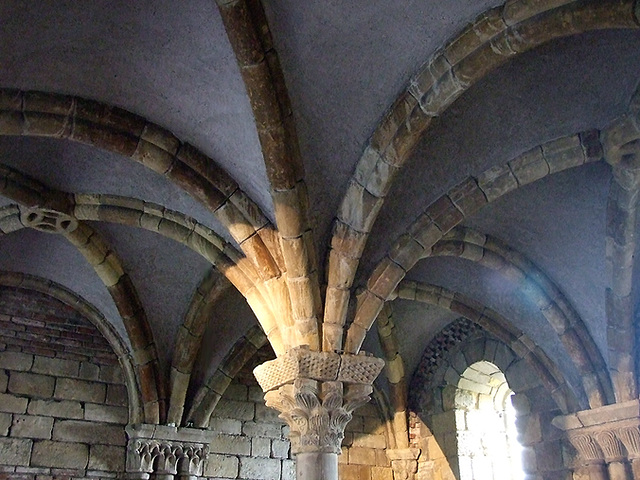Detail of the Pontaut Chapter House in the Cloiste…
Head (Perhaps of an Angel) in the Cloisters, Sept.…
Terracotta Enthroned Virgin in the Cloisters, Sept…
St. Christopher in the Cloisters, Sept. 2007
Detail of St. Christopher in the Cloisters, Sept.…
Marble Virgin and Child in the Cloisters, Sept. 20…
St. Margaret in the Cloisters, Sept. 2007
Seated Virgin and Child in the Cloisters, Sept. 20…
Mary Magdalene in the Cloisters, Sept. 2007
Wooden Statue of the Virgin and Child in the Clois…
Lion Relief in the Cloisters, Sept. 2007
Detail of one of the Head-Shaped Supports of the L…
Virgin and Child Statue in the Cloisters, Sept. 20…
Detail of a Virgin and Child Statue in the Cloiste…
Sweetmeat Fork in the Cloisters, Sept. 2007
Detail of a Virgin and Child Statue in the Cloiste…
Theodosius Arrives at Ephesus Stained Glass Panel…
Various Panels of Stained Glass in the Cloisters,…
Stained Glass Panel in the Cloisters, Sept. 2007
Sections of a Border Stained Glass in the Cloister…
Statue of a Bishop Saint in the Cloisters, Sept. 2…
Statue of the Virgin in the Cloisters, Sept. 2007
Window with Grisaille Decoration in the Cloisters,…
Saint Hubert and the Stag Relief in the Cloisters,…
Man of Sorrows Wall Painting in the Cloisters, Sep…
Head in the Cloisters, Sept. 2007
Reliquary Bust of St. Juliana in the Cloisters, Se…
Bursa Reliquary in the Cloisters, Sept. 2007
Relief with Saint Peter Martyr and Three Donors in…
Ivory Shrine with the Virgin and Child in the Cloi…
Ivory Diptych with New Testament Scenes in the Clo…
Ivory Plaque with Scenes of Christ and the Apostle…
Three Marys at the Holy Sepulcher Ivory Plaque in…
Ivory Plaque with Saint Aemilianus in the Cloister…
Ivory Plaque with St. John the Evangelist in the C…
Drinking Bowl in the Cloisters, Sept. 2007
Pair of Doors in the Cloisters, Sept. 2007
Romanesque Architectural Frieze in the Cloisters,…
Pulpit Relief with the Symbol of St. Luke in the C…
Fragment of a Relief with Three Clerics in the Clo…
Camel Wall Painting in the Cloisters, Sept. 2007
Portion of a Pilaster with an Acrobat in the Clois…
Fragment of a Figure in the Cloisters, Sept. 2007
Ivory Pyx in the Cloisters, Sept. 2007
Pieta in the Cloisters, Sept. 2007
Location
See also...
Keywords
Authorizations, license
-
Visible by: Everyone -
All rights reserved
-
285 visits
Detail of the Pontaut Chapter House in the Cloisters, Sept. 2007


Chapter House from Notre-Dame-de-Pontaut, 12th century
French; Made in Pontaut, Gascony
Limestone; Overall: 453 x 304 in. (1150.6 x 772.2 cm)
The Cloisters Collection, 1935 (35.50)
"Whenever any important business has to be done in the monastery, let the Abbot call together the whole community and state the matter to be acted upon." So Saint Benedict began Chapter 3 of his "Rule for Monasteries." The chapter house was devised to facilitate such meetings. Usually located off the cloister, chapter houses, such as this example, were generally rectangular in shape and furnished with stone-hewn benches encircling the room.
The abbot sat on a separate, often raised seat. The room was illuminated by windows on the rear wall, as well as by the arcades at the entrance. This view of the Pontaut Chapter House from Pontaut in southwest France shows the entrance from the cloister. Originally the interior walls were plastered and perhaps painted. (Some color can still be seen on the ribs of the vaults.) The decorations of the capitals and abacus blocks are imaginatively varied and include rosettes, palmettes, and basket-weave patterns as well as carvings representing pinecones.
Like many other church buildings, the abbey of Pontaut suffered from changing political fortunes and neglect: it was partially destroyed in 1569 during the Wars of Religion and was abandoned by 1791 in the aftermath of the French Revolution. By the nineteenth century, the chapter house was being used as a stable, and it fell into a dilapidated condition until its purchase in the early 1930s.
Text from: www.metmuseum.org/works_of_art/collection_database/the_cl...
French; Made in Pontaut, Gascony
Limestone; Overall: 453 x 304 in. (1150.6 x 772.2 cm)
The Cloisters Collection, 1935 (35.50)
"Whenever any important business has to be done in the monastery, let the Abbot call together the whole community and state the matter to be acted upon." So Saint Benedict began Chapter 3 of his "Rule for Monasteries." The chapter house was devised to facilitate such meetings. Usually located off the cloister, chapter houses, such as this example, were generally rectangular in shape and furnished with stone-hewn benches encircling the room.
The abbot sat on a separate, often raised seat. The room was illuminated by windows on the rear wall, as well as by the arcades at the entrance. This view of the Pontaut Chapter House from Pontaut in southwest France shows the entrance from the cloister. Originally the interior walls were plastered and perhaps painted. (Some color can still be seen on the ribs of the vaults.) The decorations of the capitals and abacus blocks are imaginatively varied and include rosettes, palmettes, and basket-weave patterns as well as carvings representing pinecones.
Like many other church buildings, the abbey of Pontaut suffered from changing political fortunes and neglect: it was partially destroyed in 1569 during the Wars of Religion and was abandoned by 1791 in the aftermath of the French Revolution. By the nineteenth century, the chapter house was being used as a stable, and it fell into a dilapidated condition until its purchase in the early 1930s.
Text from: www.metmuseum.org/works_of_art/collection_database/the_cl...
- Keyboard shortcuts:
Jump to top
RSS feed- Latest comments - Subscribe to the comment feeds of this photo
- ipernity © 2007-2024
- Help & Contact
|
Club news
|
About ipernity
|
History |
ipernity Club & Prices |
Guide of good conduct
Donate | Group guidelines | Privacy policy | Terms of use | Statutes | In memoria -
Facebook
Twitter

Sign-in to write a comment.